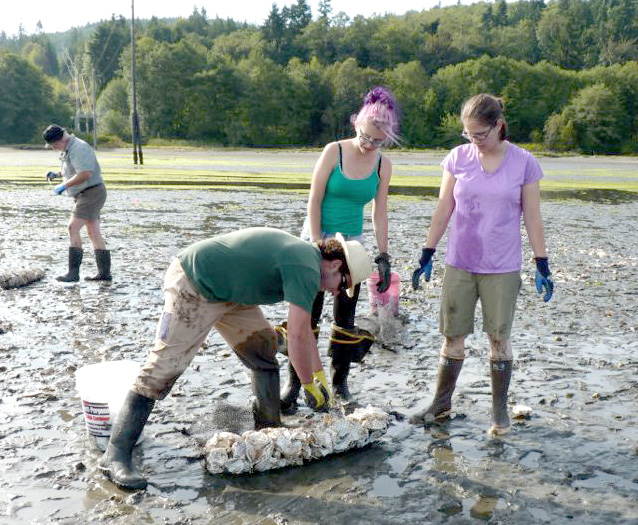DISCOVERY BAY — Volunteers with the Jefferson County Marine Resources Committee have created a new half-acre of native Olympia oyster habitat at the south end of Discovery Bay.
The group’s goal is to jump-start an expansion of the small but thriving Olympia oyster population near the project site.
With advice from Brady Blake, a biologist with the state Department of Fish and Wildlife, the Marine Resources Committee used an experimental, low-impact technique for Olympia oyster habitat restoration, said Cheryl Lowe, coordinator of the committee.
With local, state and federal permits in hand, the group used a boat and crew to move 8 cubic yards of bagged shell from a nearby staging area to the project area on the previous day’s high tide.
Volunteers from the Marine Resource Committee and WSU Beach Watchers walked out at low tide Aug. 9 to thinly scatter Pacific oyster shells and two small plots of crushed shell on the Discovery Bay tideflats across the bay from the existing population, avoiding eelgrass as they worked, she said.
“Larvae from the existing oyster population should settle on the new shell next spring, and the population is expected to slowly expand from there,” Lowe said.
Taylor Shellfish, the Jamestown S’Klallam Natural Resources Department and Port Discovery Seafarms provided advice, donation of shell and use of boat, crew and staging facilities, she added.
The Olympia oyster once thrived in coves and sheltered inlets throughout Puget Sound, but its numbers are now only a fraction of historic populations.
Pollution from mills and overfishing in the mid-1800s brought the native Olympia oyster to the brink of extinction, and by the latter half of the 20th century, small pockets of the silver-dollar-size oysters were difficult to find around Puget Sound.
What dominates oyster beds today is the Japanese or Pacific oyster.
Jefferson County Marine Resources Committee members in 2002 launched an effort to revive the native oysters, planting oyster seed in plots on Discovery Bay .
Olympia oysters help clean marine waters by filter-feeding smaller particles than Pacific oysters, removing nutrients in estuaries and tideflats.
They also provide habitat and food for many other species.
Funding for this project was provided in part by the Environmental Protection Agency and supported by the Puget Sound Partnership and Northwest Straits Commission.
For more information about the Marine Resources Committee, Olympia oysters and this restoration project, visit www.jeffersonmrc.org.

